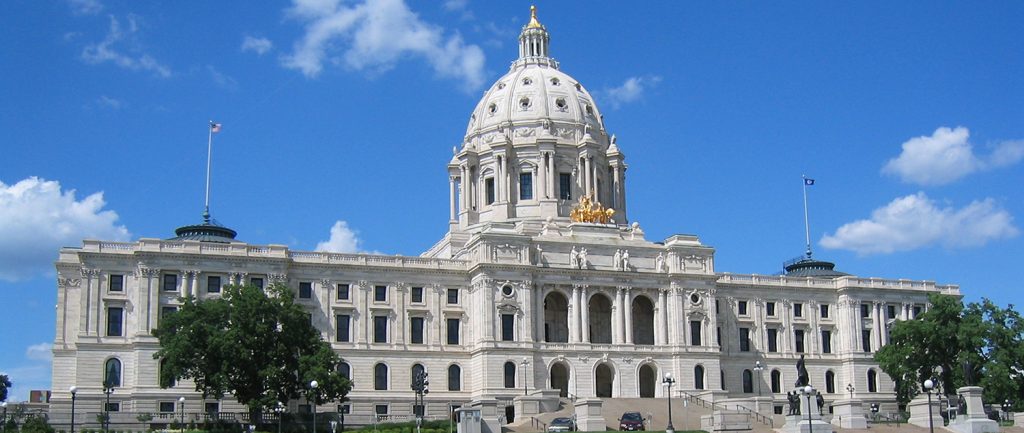In the months leading up to the 2018 election, Minnesota was a national curiosity. After Republicans nearly won the state in the 2016 presidential race, a political picture of the state emerged prior to the 2018 midterms: a blue state with deep Democratic inroads in the suburbs showing ruby red markings in rural swaths.
Politically speaking, Minnesota has become a microcosm of the United States.
“It was a fascinating election night,” says Minnesota Soybean Growers Association Executive Director Joe Smentek. “There were a lot of compelling races that went both ways. Minnesota is such a diverse state, and that was on vivid display throughout this election cycle.”
On election night, the North Star State didn’t disappoint up and down the ballot. Both parties woke up Wednesday credibly touting their respective wins. Democrats took home the biggest prizes, electing a Democratic governor (Tim Walz), an attorney general (Keith Ellison) and two senators (Amy Klobuchar and Tina Smith). Suburban voters also flipped two Republican Congressional seats. At the state level, Democrats regained the majority of the Minnesota House of Representatives, but fell one seat short of a tie in the Senate. Minnesota is now the only state with a split legislature.
The opening day of the 91st session of the Minnesota Legislature starts on Jan. 8, 2019.
“With the Democrats winning back the state House, it’s a completely different landscape in Minnesota going into the 2019 session,” says MSGA lobbyist Cory Bennett.
Meanwhile, Minnesotan Republicans were heartened by seizing two Congressional seats in Greater Minnesota: the agriculture-heavy First District and District 8, historically a Democratic stronghold, in northern Minnesota. Jim Hagedorn prevailed in a tight race over Dan Feehan in southern Minnesota’s First District, winning by fewer than 1,500 votes. Republican Pete Stauber canceled out the two Democratic suburban pickups after cruising to a win to represent the Iron Range’s Eighth District. The GOP pickups were one of the few national Republican wins in Democratic districts in an otherwise bleak night for House Republicans.
The implications for Minnesota ag producers are numerous. Walz, who has represented District 1 in southern Minnesota since 2007, will replace outgoing Gov. Mark Dayton after defeating Republican Jeff Johnson.
“Many of our farmer leaders have forged a relationship with Governor-elect Walz during his years in Congress,” says MSGA President Michael Petefish. “He’s very aware of the concerns and priorities of Minnesota farmers and hopefully he continues to promote policies that help Minnesota farmers during his term as governor.”
The Mankato resident is now charged with appointing a new commissioner of agriculture to replace retiring Commissioner Dave Frederickson. He’ll also be tackling a host of issues pertinent to Minnesota farmers, including tax conformity, rural broadband access, health care, rural mental health and the status of the buffer law.
“Throughout our visits with him, Gov.-elect Walz has expressed a desire to continue working with farmers to find common sense solution to the issues we face at the state level,” Petefish says. “He has a rural background and we look forward to working with him and his administration.”
Close calls
According to the Cook Political Report, Minnesota’s Seventh District is the most solid Republican district currently represented by a Democrat. Rep. Collin Peterson has held the seat, deep in Minnesota farm country, since 1991. After early returns showed challenger Dave Hughes winning, Peterson rallied, managing to maintain his seat with a four-point win.
Peterson’s re-election could bode well for the future of the farm bill, which has languished for months in a bipartisan battle over Supplement Nutrition Assistance Program (SNAP) benefits and work requirements. With the Democrats regaining control of the House, Peterson is expected to become chair of the House Ag Committee. He’s indicated an unwillingness to rewrite the bill, which has broad bipartisan support in the Senate, although current House Ag Chair Mike Conaway said the “election results don’t change the circumstances in farm country.”
“Rep. Peterson’s win certainly improves the prospects of the next farm bill,” Smentek says. “He’s a very influential Congressman, especially on agriculture issues. He’s another legislator who has gotten to know our farmers very well over the years.”
After their primary wins in August, Hagedorn and Feehan were locked in a contentious battle for Walz’s open First District seat. The Blue Earth, Minn., Republican was running for the seat for the third time after a close loss in 2016; this year, he continued highlighting his alliance with President Trump’s policies. Feehan, a Red Wing native and Iraq War veteran, ran with an independent message similar to Walz’s. Hagedorn’s close victory puts the First District seat in GOP hands for the first time since 2006.
The Senate races were called early in favor of Democrats. Sen. Amy Klobuchar, a potential 2020 presidential candidate, won 60 percent of the vote, including rural counties other Democrats failed to reach. Sen. Tina Smith, who was running in a special election, defeated Republican Karin Housley by 11 points. Smith will complete the term vacated by Al Franken. It’s the first time in Minnesota history both Senate seats are held by females.
“It was a spirited campaign and we thank everyone who participated in the democratic process,” Smentek said. “As a non-partisan organization, we are eager to hit the ground running, working with both parties to get our farm economy back on track.”


